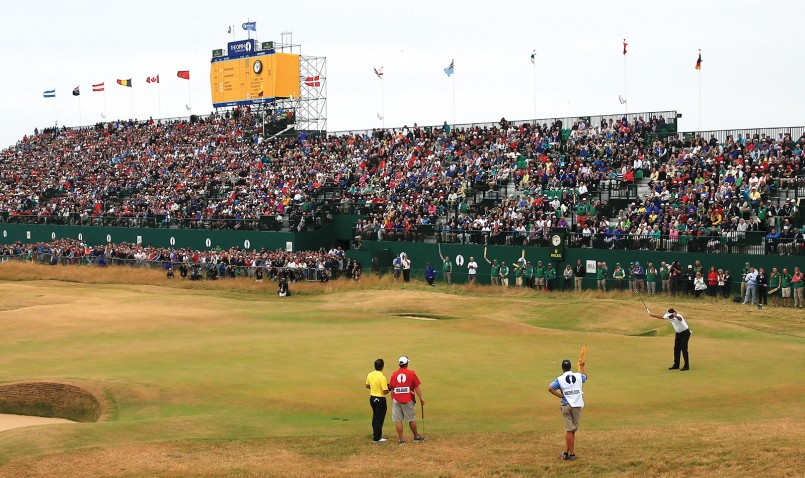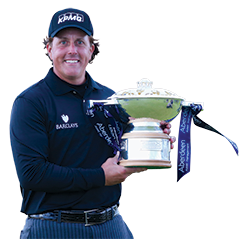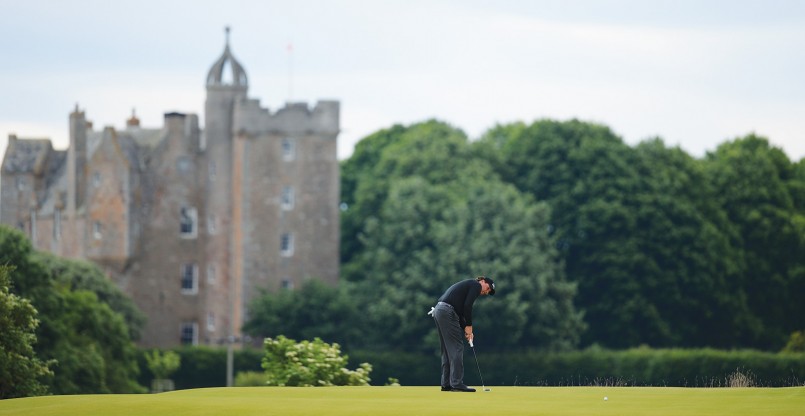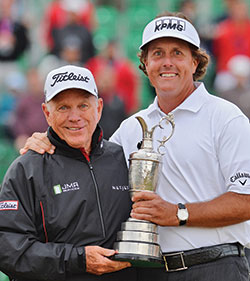
At breakfast on the final day of the [British] Open Championship last year at Muirfield, Phil Mickelson boldly announced to his wife, Amy, and their three children that he intended to bring home the Claret Jug. Now if this had been the Masters, which Mickelson had won three times, such prophecy might have been plausible. But this was the Open, in which ‘Lefty’ had a dismal record—a mere two top-10 finishes in 20 starts—and on this occasion he was five strokes behind the leader. There were numerous reasons why even Amy might have questioned her husband’s sanity.

Principally, Mickelson would have to go low on one of the fiercest tests in links golf. The course—designed by ‘Old’ Tom Morris in 1891—is the home of the Honorable Company of Edinburgh Golfers who drew up the first formal rules of the game. Its narrow, firm fairways are bordered by thin strips of “playable rough” which soon give way to knee-high native grasses. No fewer than 155 bunkers litter the course, many so diabolical that players who have the misfortune to find them have no option but to play out sideways. Then there are the ferocious winds that blow off the Firth of Forth, which can turn an 8-iron shot one day into a 3-wood the next.
There was a reason Mickelson had a bleak record in the Open, and it was not jetlag or bland British fare. Simply put, links golf had never been his game. He is a product of southern California and grew up playing courses that favor raw power off the tee and the ability to attack pins situated on lush, soft greens with precision wedge shots that impart maximum backspin. Land the ball 10 feet past the hole and spin it into the cup.
Links golf is a different animal. It is the antithesis of the power game. The challenge is to prevent your tee shot from rolling too far on the hard-baked fairways (some tee shots at Muirfield rolled over 400 yards) to find one of the sinister pot bunkers that preclude a shot to the green. Links golf also demands that you master the art of landing your approach 20 yards short in the hope, not expectation, that, if you don’t get a bad bounce, the ball rolls somewhere near the hole. Few shots were spotted spinning backwards on the greens at Muirfield. The divot repair tool was almost an endangered species.
“The type of golf you have to play in a Major is so different to any other tournament,” Mickelson reflected. “Very often in the British Open, the rough is thick, the ground firm, the winds strong and the pin positions tight. You can’t go for the flag. Most of the time you have to try to run the ball up into the middle of the greens whereas back in the States you have to go for every pin otherwise you’re going to get beat. It’s taken me a while to learn that.”
With this in mind, Mickelson (2-over par) started the last day five strokes behind Lee Westwood (3-under), who had played steady golf. A five-stroke deficit at Muirfield seemed more like 10 in an ordinary PGA Tour event. The venerable links course was yielding birdies more sparingly than Tiger Woods was signing autographs. With names like Westwood, Woods (1-under), Adam Scott (even), Angel Cabrera, Hunter Mahan and Zach Johnson (all 1-over) on the leaderboard, surely someone would put up a good number. Almost all of the attention was on the anticipated duel between Westwood, perennially seeking his first Major, and Woods, intent on breaking his five-year drought.
Finally, there were lingering questions about Mickelson’s emotional state in the wake of his heartbreaking loss at Merion the month before, where for the sixth time he had finished a U.S. Open runner-up. He called it the most painful loss of his career. “He hardly got out of bed for two days. It was the worst disappointment for him of any tournament, by far,” said Amy, the former Phoenix Suns cheerleader he met while they were fellow students at Arizona State University.
Living with Amy, though, is usually the perfect antidote to PGA Tour disappointment for Mickelson. As he recalls: “I met her when she lived above a friend of mine on the golf team. I was hanging out with this guy and he introduced me to her. We still live in the area not only because we both went to school there but because it’s easy to get to San Diego and Salt Lake City in Utah where she comes from. We liked Phoenix, so we got a house there.”
While at ASU, Mickelson claimed three successive NCAA Championships and won the 1991 Northern Telecom Open in Tucson—an incredible achievement for a 20-year-old amateur.
“I don’t know if that was the greatest moment in my life, but it was certainly a great accomplishment for me at the time. I made a triple-bogey on the 14th hole, losing my lead and looking like I was out of the tournament, then came back with a couple of birdies and won with a brilliant last hole. It was exciting but it also gave me an opportunity to turn professional straight out of college after I graduated and step straight out onto the tour without having to go through qualifying school.”

That was indeed an important platform for the fledgling Mickelson, but equally significant was his victory in the Scottish Open at Castle Stuart near Inverness, the week before his Open triumph. It encouraged him to go with the flow on the back nine at Muirfield when most of his rivals were searching for balls in knee-high gorse and slashing out of deep bunkers. At that point, Mickelson’s self-described “love-hate” relationship with links golf turned decidedly romantic. In brief, he birdied four of the last six holes to record a five-under par 66 that put him in the clubhouse on three-under-par and with a virtually uncatchable lead. Meanwhile, the rest of the field foundered. Several players were still on the course while Mickelson’s name was being engraved on the Claret Jug.
On the front nine, Mickelson birdied the 5th and 9th to get back to even par for the tournament, but no one was paying much attention. A bogey on the 10th hole seemed to stymie his momentum (he was four strokes behind Westwood at that stage), but he rallied with a birdie on 13 after flushing a 5-iron to 10 feet. “It was a putt that was going to make the rest of the round go one way or another,” said Mickelson. “Because I thought if I made it, it would give me some momentum, get me to even par for the championship, a score that I thought had a good chance of being enough.”

Mickelson followed that with a birdie at the 14th, and suddenly found himself in the lead as Scott and Westwood wobbled. After pars at the 15th and 16th, he stood on the 575-yard par-5 17th tee at one-under and knew that getting to two-under would be crucial.
Born: 16 June 1970
Turned Pro: 1992
Major Wins: 5 (Masters 2004, 2006, 2010; PGA Championship 2005; [British] Open 2013)
Professional Wins: 51
He hit two perfect 3-woods (Mickelson didn’t carry a driver in his bag that week at Muirfield) to reach the green, and two-putted for birdie. “That’s the moment I had to compose myself, because they were two of the best 3-woods I ever hit,” said Mickelson. “That’s exactly why I didn’t have a driver in the bag. Those two 3-woods were the best shots of the week, and walking up on that green is when I realized that this championship was very much in my control. And I was getting a little emotional.”
His coup de grâce was a brilliant 6-iron into the 18th green, just clearing a bunker and filtering down to the hole. Then his 12ft birdie putt extinguished any fleeting hopes that may have lingered for his rivals. If Mickelson was “a little emotional,” his caddie Jim (“Bones”) Mackay was in tears. “You’re with a guy for all that time and it’s pretty cool when you see him play the best round of his career in the last round of the British Open to win,” said Mackay. “He played the best round of golf I’ve ever seen him play.”
Reflecting on the significance of his accomplishment, Mickelson said: “I just could not be more proud to be your champion. I never knew in my career if I’d be equipped, if I would have the shots, if I would have the opportunity to win a tournament here. And to do it, to play some of the best golf, probably the best round of my career, and break through and capture this Claret Jug is probably the most fulfilling moment of my career.”

One person who was not surprised by Mickelson’s mastery of Muirfield Sunday was his swing coach, Butch Harmon. “Once he embraced links golf and took it to heart, he learned he couldn’t overpower it and had to play the shots the course gives you.” Nor was he surprised that Mickelson had shaken off the heartbreak of Merion. “The man just gets up off the mat,” Harmon said. “You can knock him down but he’s not going to stay down.”
Mickelson’s brilliant 66 at Muirfield will be remembered as one of the great final rounds for as long as the game is played. It secured his fifth Major and put him in reach of a career Grand Slam if, one day, he can shrug that U.S. Open monkey from his back. But, of course, Amy knew all this at breakfast.
Follow Us On


| Cookie | Duration | Description |
|---|---|---|
| cookielawinfo-checkbox-analytics | 11 months | This cookie is set by GDPR Cookie Consent plugin. The cookie is used to store the user consent for the cookies in the category "Analytics". |
| cookielawinfo-checkbox-functional | 11 months | The cookie is set by GDPR cookie consent to record the user consent for the cookies in the category "Functional". |
| cookielawinfo-checkbox-necessary | 11 months | This cookie is set by GDPR Cookie Consent plugin. The cookies is used to store the user consent for the cookies in the category "Necessary". |
| cookielawinfo-checkbox-others | 11 months | This cookie is set by GDPR Cookie Consent plugin. The cookie is used to store the user consent for the cookies in the category "Other. |
| cookielawinfo-checkbox-performance | 11 months | This cookie is set by GDPR Cookie Consent plugin. The cookie is used to store the user consent for the cookies in the category "Performance". |
| viewed_cookie_policy | 11 months | The cookie is set by the GDPR Cookie Consent plugin and is used to store whether or not user has consented to the use of cookies. It does not store any personal data. |